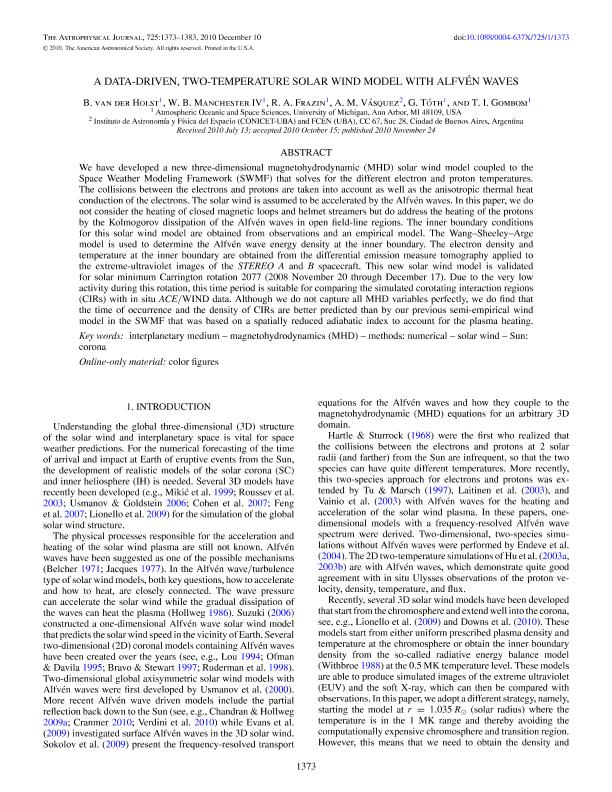Mostrar el registro sencillo del ítem
dc.contributor.author
van der Holst, B.
dc.contributor.author
Manchester IV, W. B.
dc.contributor.author
Frazin, R. A.
dc.contributor.author
Vasquez, Alberto Marcos

dc.contributor.author
Tóth, G.
dc.contributor.author
Gombosi, T. I.
dc.date.available
2017-07-11T20:01:49Z
dc.date.issued
2010-12-10
dc.identifier.citation
van der Holst, B.; Manchester IV, W. B.; Frazin, R. A.; Vasquez, Alberto Marcos; Tóth, G.; et al.; A data-driven, two-temperature solar model with Alfven waves; IOP Publishing; Astrophysical Journal; 725; 1; 10-12-2010; 1373-1383
dc.identifier.issn
0004-637X
dc.identifier.uri
http://hdl.handle.net/11336/20160
dc.description.abstract
We have developed a new three-dimensional magnetohydrodynamic (MHD) solar wind model coupled to the Space Weather Modeling Framework (SWMF), that solves for the different electron and proton temperatures. The collisions between the electrons and protons are taken into account as well as the anisotropic thermal heat conduction of the electrons. The solar wind is assumed to be accelerated by the Alfv en waves. In this paper, we do not consider the heating of closed magnetic loops and helmet streamers, but do address the heating of the protons by the Kolmogorov dissipation of the Alfv n waves in open field line regions. The inner boundary conditions for this solar wind model are obtained from observations and an empirical model. The Wang-Sheeley-Arge model is used to determine the Alfv n wave energy density at the inner boundary. The electron density and temperature at the inner boundary are obtained from the differential emission measure tomography applied to the extreme ultraviolet images of the STEREO A and B spacecraft. This new solar wind model is validated for solar minimum Carrington rotation 2077 (November 20 through December 17, 2008). Due to the very low activity during this rotation, this time period is suitable for comparing the simulated Corotating Interaction Regions (CIRs) with in-situ ACE/WIND data. Although we do not capture all magnetohydrodynamic variables perfectly, we do find that the time of occurance and the density of CIRs are better predicted than by our previous semi-empirical wind model in the SWMF that was based on a spatially reduced adiabatic index to account for the plasma heating.
dc.format
application/pdf
dc.language.iso
eng
dc.publisher
IOP Publishing

dc.rights
info:eu-repo/semantics/openAccess
dc.rights.uri
https://creativecommons.org/licenses/by-nc-sa/2.5/ar/
dc.subject
Solar Wind
dc.subject
Mhd
dc.subject
Sun: Corona
dc.subject
Sun: Waves
dc.subject
Interplanetary Medium
dc.subject
Methods: Numerical
dc.subject.classification
Astronomía

dc.subject.classification
Ciencias Físicas

dc.subject.classification
CIENCIAS NATURALES Y EXACTAS

dc.title
A data-driven, two-temperature solar model with Alfven waves
dc.type
info:eu-repo/semantics/article
dc.type
info:ar-repo/semantics/artículo
dc.type
info:eu-repo/semantics/publishedVersion
dc.date.updated
2017-07-11T13:11:29Z
dc.journal.volume
725
dc.journal.number
1
dc.journal.pagination
1373-1383
dc.journal.pais
Reino Unido

dc.journal.ciudad
Londres
dc.description.fil
Fil: van der Holst, B.. University of Michigan; Estados Unidos
dc.description.fil
Fil: Manchester IV, W. B.. University of Michigan; Estados Unidos
dc.description.fil
Fil: Frazin, R. A.. University of Michigan; Estados Unidos
dc.description.fil
Fil: Vasquez, Alberto Marcos. Consejo Nacional de Investigaciónes Científicas y Técnicas. Oficina de Coordinación Administrativa Ciudad Universitaria. Instituto de Astronomía y Física del Espacio. - Universidad de Buenos Aires. Facultad de Ciencias Exactas y Naturales. Instituto de Astronomía y Física del Espacio; Argentina
dc.description.fil
Fil: Tóth, G.. University of Michigan; Estados Unidos
dc.description.fil
Fil: Gombosi, T. I.. University of Michigan; Estados Unidos
dc.journal.title
Astrophysical Journal

dc.relation.alternativeid
info:eu-repo/semantics/altIdentifier/doi/http://dx.doi.org/10.1088/0004-637X/725/1/1373
dc.relation.alternativeid
info:eu-repo/semantics/altIdentifier/url/http://iopscience.iop.org/article/10.1088/0004-637X/725/1/1373/meta
Archivos asociados
